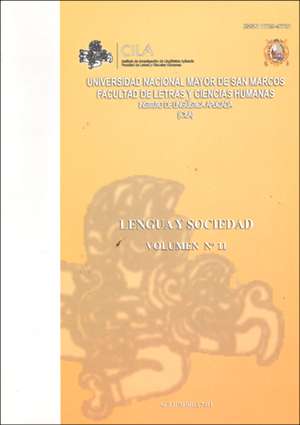On the phonetics of glottal stops and larangized phonation: Cases of Amerindian languages
DOI:
https://doi.org/10.15381/lengsoc.v11i1.22028Keywords:
Shipibo, Capanahua, Boruca, glottal stop, creaky voice, acoustic documentationAbstract
In this study, I examine sorne of the articulatory and acoustic properties present in the phonetic realization of glottal stops. In particular, I focus on two tendencies languages show when they realize this type of segments: full closure of the vocal folds and creaky voice. I show through examining the language Boruca that creaky voice can occur without the aperiodic vibration ofthe vocal folds. In this language, a decrease of the fundamental frequency and intensity can serve alone as a phonetic cue to detect creaky voice. I also examine the influence that prosodic structure can have on restricting the spreading of creaky voice within a vowel. Particularly, 1 present the cases of two Panoan languages, Capanahua and Shipibo, in which vowels of syllables in strong prosodic positions tend to resist having creaky voice throughout their duration. In contrast, vowels that belong to weak syllables do tend to appear completely in creaky voice.
Downloads
Published
Issue
Section
License
Copyright (c) 2011 José Elías-Ulloa

This work is licensed under a Creative Commons Attribution 4.0 International License.
AUTHORS RETAIN THEIR RIGHTS
a. Authors retain their trade mark rights and patent, and also on any process or procedure described in the article.
b. Authors can submit to the journal Lengua y Sociedad, papers disseminated as pre-print in repositories. This should be made known in the cover letter.
c. Authors retain their right to share, copy, distribute, perform and publicly communicate their article (eg, to place their article in an institutional repository or publish it in a book), with an acknowledgment of its initial publication in the journal Lengua y Sociedad.
d. Authors retain theirs right to make a subsequent publication of their work, to use the article or any part thereof (eg a compilation of his papers, lecture notes, thesis, or a book), always indicating its initial publication in the journal Lengua y Sociedad (the originator of the work, journal, volume, number and date).






